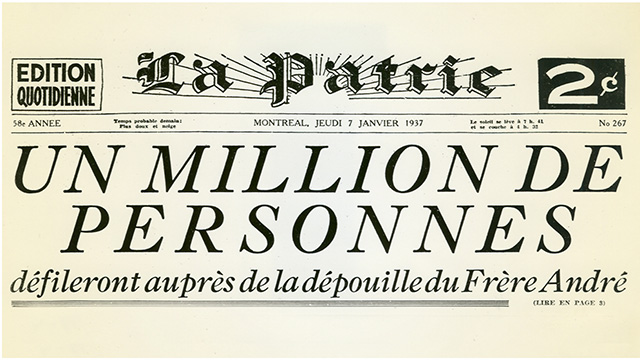Remembering January 6, 1937

Montreal
Eighty years ago, on January 6, 1937, death came for Brother André shortly after midnight. His passing made headlines in all the papers. Grief; dismay; people wept for their friend. (The image above, from the French language newspaper "La Patrie", reads "A million people will line up in front of Brother André's remains")
Some facts to remember...
The story of the last moments of Brother André's life and that of his death was featured in 860 newspaper articles across Canada and the United States.
- Expecting great crowds of mourners, religious authorities thought it wise to hold two funeral services. On January 9, a first service was held in the Montreal Cathedral, and a second, three days later, on Tuesday, January 12, in the Oratory Crypt.
- Brother André lay in a mortuary chapel in the Crypt from the afternoon of Wednesday, January 6 until Saturday morning, and then again for two days after the first service. His coffin was laid in front of the main entrance to the Oratory. It was surrounded by hundreds of crutches, canes, and other objects left behind by grateful pilgrims.
- On this cold week of January 1937, everyone wanted to see him. The crowds stretched from the street below to the very doors of the Oratory, way up on the mountain.
- Five hundred firemen and policemen were put to task to maintain order during the week that Brother André's body lay in state. Visitors, chilled to the bone, were requested not to stay more than a few seconds before the coffin of the aged Brother.
- To allow the greatest number of visitors to see him, a constant rhythm of 110 people a minute was maintained: thus, seventy-five to a hundred thousand people filed past him each day.
- In the United States, where Brother André was well known, special trains were put at the disposal of visitors from Maine, Massachusetts, Connecticut, Rhode Island, New Hampshire and Vermont.
"Why such manifestations of popular mourning, such outpouring of affection for Brother André?," asked Jean-Guy Dubuc. "Perhaps because the little Brother gave special meaning to the lives of the people who loved him so much: he embodied their hope. He only said a few words to his visitors. He was never long-winded, and he always used speech and gestures sparingly. Yet, everyone seemed to leave him with rekindled strength, and with a new reason to hope."
Source Saint-Joseph's Oratory Blog
By Nathalie Dumas

Comment
0 Comment
Add new comment